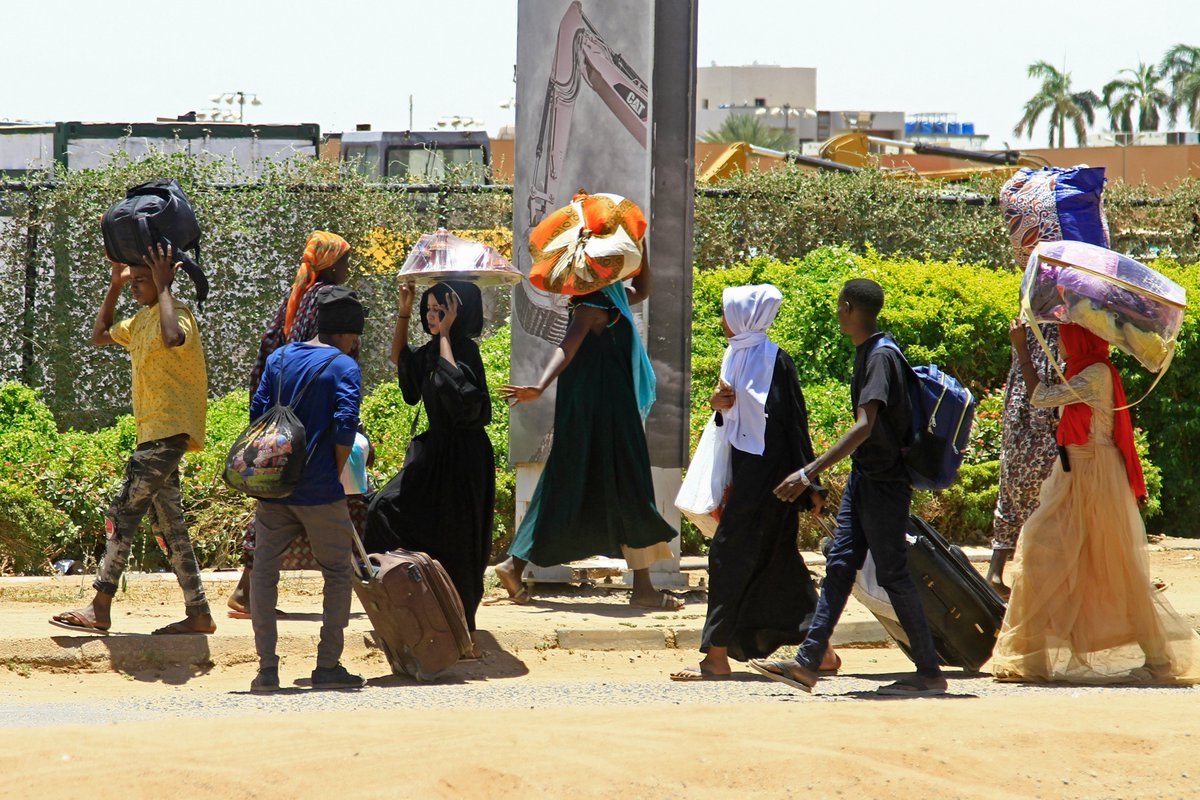

As the civil war enters its second year, 25 million people urgently need humanitarian assistance in Sudan.
It is now one of the fastest unfolding crises in the world.
The people of Sudan had endured a protracted crisis long before the civil war began in April 2023. The recent conflict, however, has plunged the country into an even deeper humanitarian crisis and worried experts who are now seeing attacks on previously unaffected areas.
The world’s largest hunger crisis looms, with unprecedented needs emerging. Almost 37% of the population is highly food insecure, with 4.9 million on the verge of starvation.
Sudan also has the highest number of internally displaced people in the world. As of April 2023, more than 8.6 million people had been recently displaced, of which about 2 million had crossed into neighboring countries. Sudan’s civil war has caused a growing refugee crisis and risk of spillover to the broader region.
Amid mass displacement, food insecurity and access impediments, humanitarian partners are seeing challenging conflict landscapes, including funding shortfalls, making it extremely hard to reach vulnerable communities.
In August 2023, CDP posted a call to action for funders to address the inequities in how philanthropy has responded to Sudan compared to other conflicts, such as the crisis in Ukraine.
Regional crises in neighboring countries exacerbate the challenges in Sudan. CDP also maintains profiles on the complex emergencies in Ethiopia and South Sudan, as well as the hunger crisis in the Horn of Africa.
(Photo: People fleeing violence in Sudan. Credit: USAID Bureau for Humanitarian Assistance Lead via Twitter)
Since its independence from Britain in the 1950s, Sudan has experienced cycles of coups, insecurity and civil wars. The complex crisis over decades has contributed to poor economic conditions, internal and cross-border displacements, widespread food insecurity, and a lack of essential services, particularly health care. Extreme weather events further exacerbate these conditions.
The 2019 Sudanese Revolution marked the end of President Omar al-Bashir’s thirty-year dictatorship, one of Africa’s longest-ruling leaders, and paved the way for a transition toward civilian rule and democracy. However, a military coup by General al-Burhan in October 2021 added new dangers to the transition and the country. International financial support and debt relief amounting to billions of dollars were paused following the coup, worsening the economic crisis and humanitarian situation in the country.
On April 15, 2023, fighting broke out between the Sudanese Armed Forces (SAF), led by Gen. Abdel Fattah al-Burhan, and the Rapid Support Forces (RSF), led by Gen. Mohamed Hamdan Dagalo (known as “Hemedti”). The fighting, which initially started in Khartoum over a dispute on the integration of the RSF into the army, quickly escalated to a civil war and spread to other areas, including Darfur, North Kordofan and Gezira state. The conflict has led to mass civilian suffering and large-scale destruction.
RSF’s origins are rooted in the Janjaweed militia that carried out ethnic cleansing in Darfur in starting 2003. The RSF seems to be hiding in urban areas, as so much of the conflict is happening in densely populated areas and is impacting civilians.
Just a few days shy of the first anniversary of the conflict and the ‘International Humanitarian Conference for Sudan and its Neighbors’ on April 15, humanitarian partners CARE International, Concern Worldwide, Islamic Relief and International Rescue Committee urged a broader scale-up of humanitarian response, renewed efforts for an immediate ceasefire and increased funding for all humanitarian actors, including local and natural aid groups. This comes after the SAF rejected the UN Security Council’s appeal for a Ramadan truce on March 9.
The lack of funding has also been a consistent issue both human rights and humanitarian organizations raised.
On Sept. 12, 2023, 50 human rights and humanitarian organizations said, “Donors should step up humanitarian funding, both for local and international organizations who are providing indispensable assistance in Sudan and neighboring countries. The costs of inaction are mounting.”
Latest Updates
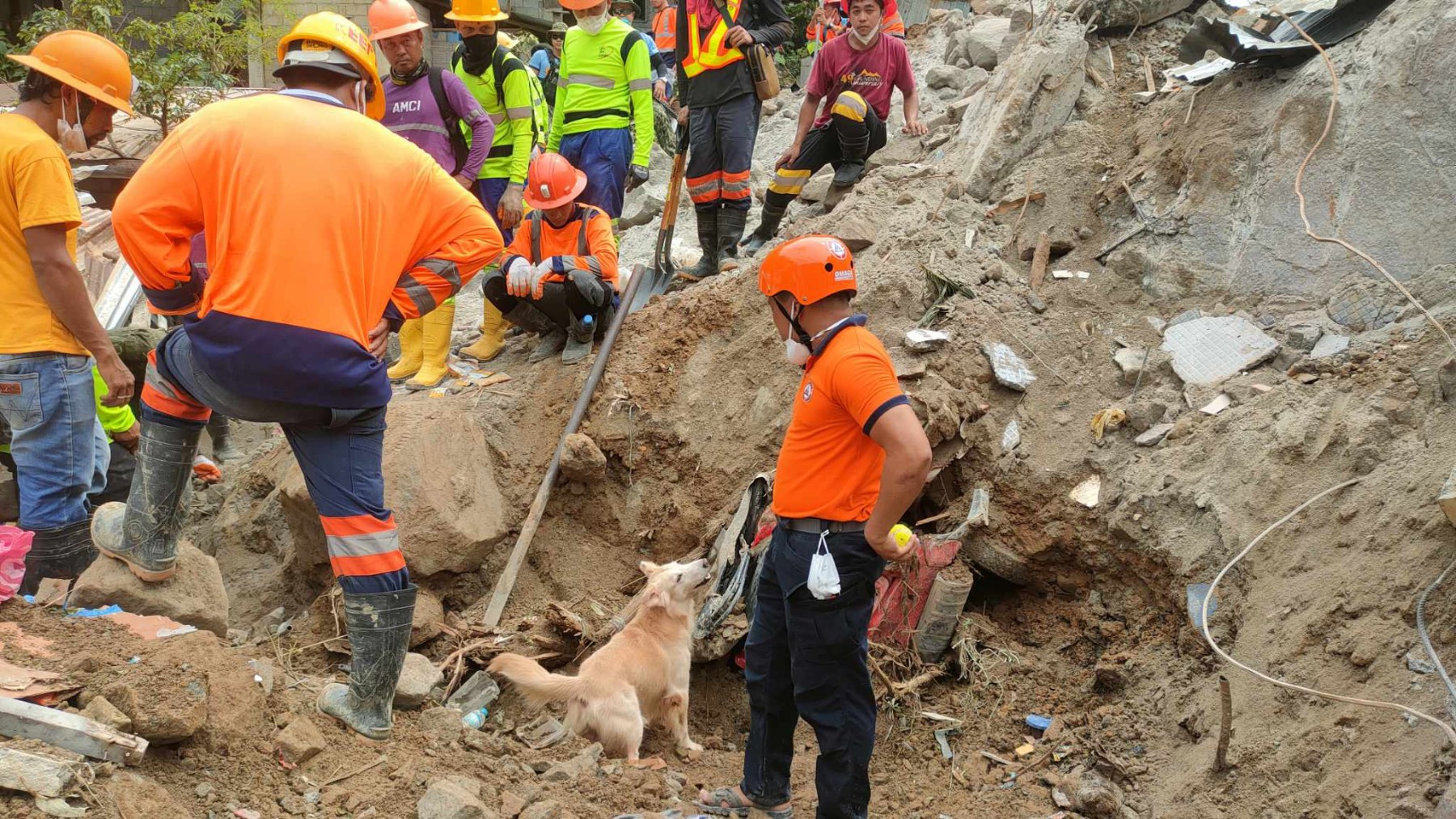
What we’re watching: Weekly disaster update, February 12

What we’re watching: Weekly disaster update, December 4
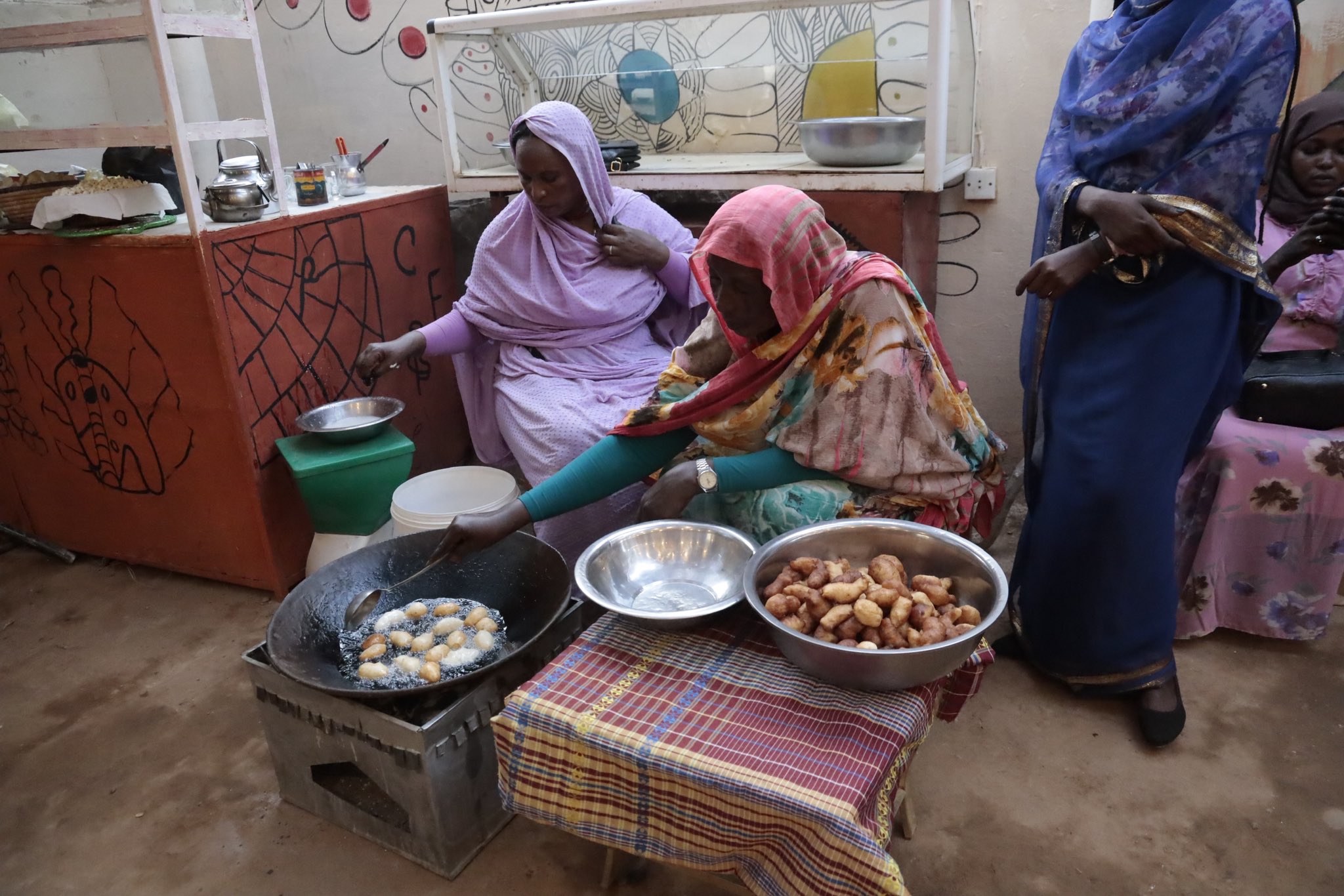
No one’s paying attention: The crisis in Sudan

What we’re watching: Weekly disaster update, July 17
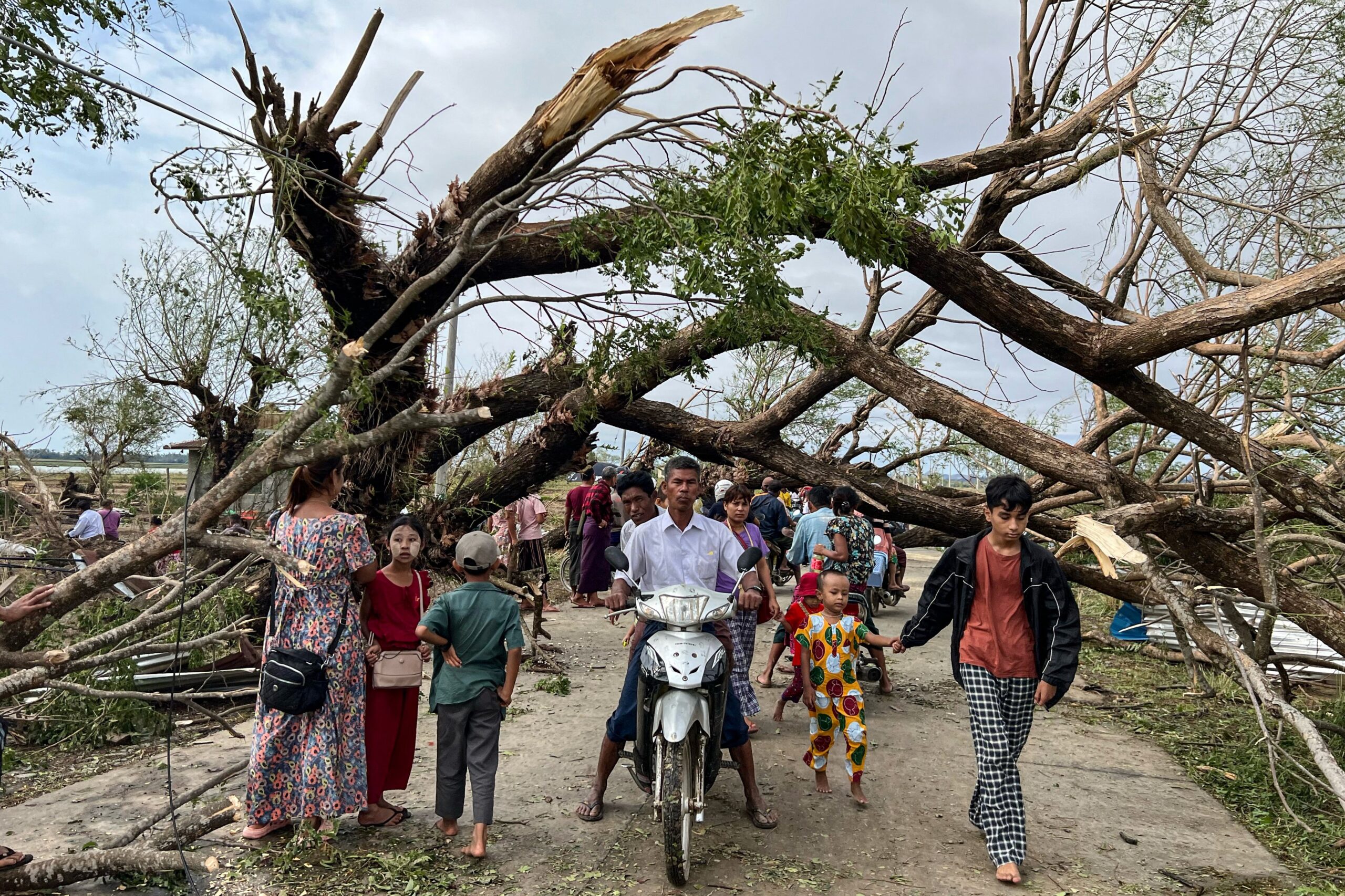
What we’re watching: Weekly disaster update, May 15
Key facts
- Since fighting broke out on April 15, 2023, more than 15,500 fatalities were recorded in the most recent report from the Armed Conflict Location & Event Data Project (ACLED).
- In addition to Sudan’s standing vulnerability to conflict, disasters associated with natural hazards, disease outbreaks and economic deterioration, the Sudan Humanitarian Needs and Response Plan (HRP) 2024 found extensive damage to critical infrastructure. An estimated 70% of health facilities in conflict-affected states are non-operational.
- It is expected that 25 million people in Sudan, more than half the population, will need humanitarian assistance in 2024. Of those, 26% are women and 48% are children. IOM predicts this could grow to 26.5 million – a significant increase from previous years: 15.8 million people in January 2023 and 14.3 million in 2022.
- According to the Famine Early Warning Systems Network (FEWS NET), famine warnings are in place from March to September 2024 in Khartoum, West Darfur and hard-to-access areas of Darfur region with high concentrations of displaced people.
- The International Organization on Migration’s (IOM) Displacement Tracking Matrix found an estimated 6.6 million internally displaced people (IDP) since April 15, 2023.
- Women and girls are disproportionately impacted by conflict, where sexual violence is used as a weapon of war. According to CARE International, “Even before the most recent conflict, a staggering 3 million women and girls lived in fear of sexual or gender-based violence.”
- Humanitarian workers have faced increasing violence. Dozens of warehouses and offices of humanitarian operations were looted. More than 200 vehicles have been stolen from humanitarian aid workers. Despite this, 163 organizations support the people of Sudan, including 87 national nongovernmental organizations (NGOs), 58 international NGOs, 11 UN agencies, six government partners and the Sudanese Red Crescent.
- The conflict has taken a toll on the economy, resulting in Sudan’s real gross domestic product (GDP) likely decreasing by 18.3% in 2024. The conflict has halted production and destroyed human capital and the country’s industrial, financial and technology base.
Widespread violence and access impediments
Since the start of the current civil war, civilians, including humanitarian personnel, have been killed in both deliberate and indiscriminate attacks by both the RSF and SAF.
As of April 5, 2024, there have been more than 15,550 deaths, including military and civilian casualties, according to ACLED.
The latest situation update also found that between Feb. 10 and March 8, 2024, 140 battles and almost 120 events of violence against civilians were recorded. During this period, the number of incidents of violence against civilians was 89% higher than in the previous four weeks.
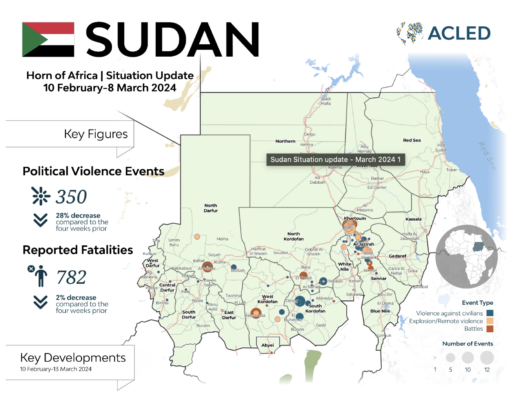
Researchers have mentioned that these numbers are “a conservative estimate due to methodological limitations of real-time reporting in a conflict of this nature.”
The Guardian has also emphasized this point, saying, “But that figure is a significant underestimate, because much of the country is too dangerous for observers to enter.
The violence and insecurity have resulted in movement restrictions for Sudanese populations and humanitarian actors, preventing many from receiving aid. In December 2023, ACAPS released its annual Humanitarian Access snapshot and rated the constraints on humanitarian access in Sudan as extreme (5 out of 5).
Previous concerns about human rights abuses were amplified by the current civil war after a new UN report detailed horrific violations and abuses by the RSF and SAF. The report details the use of arbitrary detention, torture, sexual violence on women and girls, recruitment of child soldiers and extreme violence, such as beheading against civilians.
As the war spirals and atrocities mount, the U.S. determined the two warring parties have committed war crimes, including crimes against humanity and ethnic cleansing in Darfur.
Displacement
Since the start of the conflict, more than 8.7 million people have been displaced within and across borders, making it the largest internal displacement crisis in the world.
Before the outbreak on April 15, 2023, Sudan was already hosting approximately 3.8 million IDPs, many of whom were displaced during the 2003 crisis in Darfur. The number of IDPs grew exponentially over the last year, representing over five times the number of individuals displaced in 2022. Women make up almost 70% of IDPs.

Khartoum remained the top state of origin, with approximately 54% of IDPs displaced since April 2023, followed by South Darfur and Aj Jazirah. On December 15, 2023, new clashes in Wad Medani between SAF and RSF led to the widespread displacement of almost 625,000 IDPs. This also resulted in a suspension of all humanitarian aid operations.
Meanwhile, over 1.8 million people, primarily women and children, have fled Sudan and sought refuge in neighboring countries, Central African Republic (CAR), Chad, Egypt, Ethiopia and South Sudan. Many of the countries were already hosting large numbers of refugees and IDPs on insufficient funding, limited supplies and poor infrastructure. There is significant fear and potential for the crisis in Sudan to develop into a regional one due to spillover of conflict, political tensions, and trade and economic disruptions.
Even after one year of war, thousands are crossing borders. In South Sudan, on average, 1,800 people arrive daily, exacerbating ongoing humanitarian needs. As of April 2024, nearly 640,000 Sudanese refugees have entered South Sudan.
Similarly, the UN Refugee Agency (UNHCR) in Egypt has seen a five-fold increase in refugees in the last year, with the daily average between 2,000 to 3,000 asylum-seekers from Sudan.
Humanitarian organizations supporting the influx of refugees are seeing dwindling supplies and resources. Most recently, in Chad, hundreds of Sudanese refugees in camps are unable to access vital medical care for injuries sustained during battles in Sudan. According to Nour-eldieen Mohamed, “there are not enough doctors here.”
Collapsing health care system
One year since the conflict in April 2023, Sudan’s health system has been stretched to near collapse despite the rise in disease outbreaks, malnutrition and non-communicable diseases. Approximately two-thirds of the Sudanese population does not have access to healthcare, and between 70-80% of health facilities are no longer functioning.
To make matters worse, systematic blocking of aid and attacks on humanitarian actors have prompted aid organizations like Médecins Sans Frontières to warn of suspension of operations and to close hospitals temporarily.
According to the World Health Organization (WHO) Surveillance System of Attacks on Healthcare, since the start of the conflict until April 17, 2024, WHO has verified 62 attacks on health care, resulting in 38 deaths and 45 injuries. Of these, 40 attacks impacted facilities, 25 impacted personnel, 17 impacted supplies, eight impacted transport, eight impacted patients and seven impacted warehouses.
Insecurity and staff shortages, as well as shortages in medical supply, electricity and water, hamper ongoing health care support and access. The scale of deaths due to lack of access isn’t precise. However, it is important to note that even before the most recent conflict, the health care system suffered severely. Almost 80% of health services were based in the capital, Khartoum, meaning that when the conflict erupted in Khartoum, the entire health care system was debilitated.
As of April 3, 2024, a Public Health Situation Analysis by WHO and the Health Cluster found over 11,000 suspected cases of cholera and 305 deaths were reported across the country. In addition to ongoing disease outbreaks, including 5,000 cases of measles and 1.3 million clinical cases of malaria, mental health and non-communicable diseases are considered high health risks. Given access impediments, data is only representative of areas humanitarians have been able to reach, and numbers may likely be higher than reported.
Negative health implications, such as malnutrition, remain a substantial problem and of exceptionally high risk among vulnerable populations, including IDPs, refugees and individuals in camp settings.
Hunger
Almost 5 million people are on the brink of starvation due to intense conflict and humanitarian access constraints, coupled with continued economic decline. Save the Children reported nearly 230,000 children and new mothers are likely to die in the coming months due to hunger and malnutrition.
The Integrated Food Security Phase Classification (IPC) results showed a dire picture of increasing food insecurity and malnutrition across Sudan. Over 17 million people, 37% of the population, are in high levels of acute food insecurity, classified in Phase 3 or above (Crisis or worse) between October 2023 and February 2024.
On March 29, the IPC released an alert for Sudan due to a dramatic increase in food insecurity and risk of famine (IPC Phase 5) in Khartoum, West Darfur and hard-to-reach areas of Darfur. The alert shared that ongoing fighting in Sudan has endangered the production of staple crops and contributed to soaring food prices and market inaccessibility. In addition, a joint update in February 2024 by the Food and Agriculture Organization and WFP indicated the prices of grains could increase by 50 to 100%. In 2023, food prices were 228% higher than between 2021-2022, and the average cost of a local food basket was 88% higher than before the conflict.
Hunger and starvation are causing already vulnerable populations to take up harmful coping mechanisms. With aid groups unable to reach areas in Darfur, specifically IDP camps, Coordination for Displaced Persons and Refugees in Darfur reported that eight out of every 10 families in camps eat only one meal a day. Similarly, Save the Children nutrition experts see pregnant women skip meals to allow their children to eat.
Humanitarian partners warn of mass deaths from hunger without immediate critical action.

Economic crisis and livelihoods
Even prior to the outbreak of conflict in April 2023, Sudan’s economy suffered from rampant inflation, shortages of basic goods and high poverty rates.
While the GDP was expected to grow in 2023, the war has caused the economy to decline rapidly. Food prices have increased dramatically, and the banking system has essentially collapsed. The informal economy is currently behind much of the employment.
In 2023, the economy in Sudan shrunk by 40% due to the fighting and is predicted to shrink by an additional 28% in 2024, according to the Finance Minister, Gibril Ibrahim. This number is higher than the 18.3% projected by the International Monetary Fund for 2024.
The conflict has greatly damaged critical infrastructures like public facilities, roads and foreign trade and exports. Due to heavy battles and damages in Khartoum, an alternative capital may soon be established.
The economic crisis has decimated livelihoods and led to the collapse of economic activity, particularly commerce, finance and technology. Nearly half of Sudan’s population is unemployed. Internet and communication blackouts for months and the collapse of the banking sector have left millions struggling to access essentials, use mobile money services and seek safety.
The economic crisis continues to exacerbate widespread poverty and humanitarian needs.
Extreme weather
Sudan is one of the ten countries most vulnerable to climate change.
These vulnerabilities include seasonal rains becoming more unpredictable, increasingly frequent droughts and rise in temperature. Land degradation and forestation compound the impacts of climate hazards.
Climate change has also been a source of conflict due to competition for water resources, grazing land and pastures. Among the most impacted and vulnerable to extreme weather events are farmers, whose livelihood and survival depend on their agricultural production and nomadic tribes, who use ancient migratory routes seasonally along with grazing animals.
In May 2023, Practical Action released a report highlighting the linkage between conflict, displacement, climate change and environmental damage. It found that climate change can bring additional pressures, such as diseases and pests, making farmers vulnerable to extreme climate patterns. Meanwhile, for nomads, migratory routes and pastureland turned into farmland, drought, and floods can reignite conflict and cause competition over limited resources.
According to UNEP research, “approximately 40% of internal conflicts over the past six decades can be attributed to the exploitation of natural resources, including competition over scarce resources, such as fertile land and water.”
Vulnerable populations
The conflict has an outsized impact on women and girls, particularly new mothers. The lack of available health care, high food insecurity and displacement have caused many to forego meals and health care services.
The conflict in Sudan has led to an increase in the risks of gender-based violence (GBV), with women bearing the brunt of displacement, food insecurity, and unmet sexual and reproductive health needs. According to CARE International’s recent advocacy brief, since April 2023, a nearly 60% increase in the number of women and girls in need of GBV services was reported. The conflict has also reversed gains made during the transitional period and effectively created a “war on women.”
Of the more than eight million people displaced in Sudan, it is estimated that at least four million of these are children, making it the largest child displacement in the world. Due to the ongoing conflict, children are losing out on education, and an entire generation of Sudan’s children are exposed to the impact of war and trauma, some as child soldiers. As a result of the conflict, harmful coping mechanisms such as child marriage and reduced food intake are being reported.
In addition to children, women and displaced people, farmers and nomad communities have long been at the crossroads of conflict. Tension has led to strife across the country, commonly due to competition over resources, crop and land damage by livestock, and limited water supply. Drought and floods, among other extreme weather shocks, further exacerbate these tensions.
Four areas need to be addressed in the Sudan humanitarian response:
- Advocating for solutions through a long-term political process that brings lasting peace and stability. This means ensuring all actors, including philanthropy, engage in a do-no-harm approach and maintain conflict sensitivity.
- Providing for immediate humanitarian needs is an important initial step to allow improved recovery. Improving humanitarian access and reach and the ability of those in need to find humanitarian services is vital.
- Supporting vulnerable populations such as women, children, IDPs and refugees through protection and provision of essential services.
- Addressing the needs of host communities in neighboring countries, specifically when local infrastructures and systems are not equipped and adequate to respond to the influx of Sudanese refugees and asylum-seekers.
During any complex humanitarian emergency (CHE), immediate needs always include shelter; food; WASH; emergency health care; education; protection of at-risk populations and case management. These needs will continue throughout the course of the CHE. As the crisis becomes more protracted issues include restoration of livelihoods, mental health, cash assistance, as well as preventative disease and chronic health disease management.
Cash assistance
As with most disasters and emergencies, cash donations are recommended by disaster experts as they allow for on-the-ground agencies to direct funds to the most significant area of need, support economic recovery and ensure donation management does not detract from disaster recovery needs and quickly re-establishing access to basic needs.
Specific to Sudan, where the conflict has severely curtailed physical movement and banking operations, digital banking applications and wallets have become a lifeline for many. Since the conflict, lack of cash has led many to utilize digital wallets to cover necessities, pay for travel and receive money from abroad. Financial applications, however, suffer from frequent telecommunication and power breakdowns.
CDP recommends cash as a donation method and a recovery strategy. Direct cash assistance can allow families to purchase items and services that address their multiple needs. It gives each family flexibility and choice, ensuring that support is relevant and timely. Cash-based approaches to disaster recovery also give people the freedom to choose how they rebuild their lives and provide a pathway to economic empowerment.
Conflict sensitivity
Humanitarian actors and philanthropy must engage in a conflict-sensitive manner that utilizes ‘do-no-harm,’ a minimum obligation for any action working in and on conflict. The fighting in Sudan is myriad and requires a deep understanding of the key players, stakeholders and civil society.
The Conflict Sensitivity Facility (CSF) supports donors and humanitarian aid organizations adopting conflict-sensitive practices to avoid feeding into conflict and maximize their contribution towards peace.
On the one-year anniversary, CSF rolled out four top priorities to prevent sustaining the ongoing violence in the country. Priorities include investment in analysis and learnings to ensure short-term access goals do not exacerbate long-term conflict drivers, support local-level conflict resilience and intercommunal relationships, flexible funding for mutual aid networks and local responders, and lastly, aid sector accountability to Sudan’s civilians to ensure long-term prospects for peace and recovery.
To ensure partners and funders not only address immediate humanitarian needs but also contribute towards long-term recovery, remaining conflict-sensitive is vital.
Protection
Protection has been an ongoing humanitarian concern in Sudan due to the protracted nature of conflict, displacement and other forms of violence. The most recent fighting has resulted in the U.S. and the UN declaring potential international human rights and humanitarian law violations due to indiscriminate attacks on civilians and blockage of aid.
In addition to violation of laws, displacement contributes to and exacerbates protection risks. Displaced populations, including refugees, are particularly vulnerable to violence, exploitation and abuse and therefore require enhanced protection.
Protection concerns are growing, particularly for at-risk groups, including children, women, elderly persons and persons with disabilities.
Donors can address funding shortfalls and ensure humanitarian partners have the funding required to carry out interventions and services that address the various needs of vulnerable populations. One way is to contribute towards Sudan’s Regional Refugee Response Plan, seeking $1.4 billion to assist over 2.7 million people in five neighboring countries.
Ensuring a solid response to immediate humanitarian needs may help establish a path towards recovery.
Humanitarian access
Aid organizations face many challenges in delivering goods and services to people in need and accessing vulnerable communities. Specific access constraints include looting, high bureaucratic impediments, roadblocks, communication blackouts and lack of cash, among many others.
To understand the challenges and timelines, UN OCHA created this video.
Despite access challenges, over 8.1 million people have received lifesaving assistance. An additional 5.7 million people have been provided agriculture and livelihood support since April 15, 2023.
Funders can respond to issues of access in a few ways. The first is to understand the constraints that humanitarian agencies are operating under. It isn’t possible to predict all possible outcomes, and there may be additional costs or changed timelines.
Second, trust the organizations who have time and experience in the region. They know what is needed, how to maneuver and how to respond.
Third, be generous and flexible in your funding to allow agility. Let organizations lead, with input and direction from the Sudanese people. Finally, engage in advocacy for funding, a ceasefire and for all parties to uphold international human rights and humanitarian laws.
Support local initiatives
Due to restrictions on international humanitarian aid movements and operations, including suspension of programs and layoff of local staff, funders can support locally led mutual aid networks and services to help alleviate humanitarian needs.
Mutual support and locally led aid efforts by volunteers have been instrumental in supporting people, particularly those trapped by conflict or in hard-to-reach areas for international humanitarian partners. Their efforts are mainly supported by local groups, businesses and members of the diaspora; however, they need more financial support. Within refugee settlements, community initiatives by the larger Sudanese diaspora and refugees have aided thousands of families yet run on low budgets.
Funders can bolster local networks as an alternative to international partners by ensuring limited, deep-seated bureaucracy. Additionally, due to the risks of attention from conflict parties and security, funders may follow in the footsteps of current international organizations who have decided not to speak publicly about their efforts. As the critical need for aid is ongoing, funders and international agencies must ensure that local initiatives and mutual aid networks are not just seen as a short-term solution to overcome access barriers but a long-term way of delivering humanitarian assistance.
Additionally, supporting refugee-led aid organizations (RLO) may mean a shift in how funders have previously coordinated with humanitarian organizations and move away from widespread negative perceptions of RLOs.

The Center for Disaster Philanthropy has a Global Recovery Fund that provides an opportunity for donors to meet the ongoing and ever-expanding challenges presented by global crises.
Contact CDP
Philanthropic contributions
If you have questions about donating to the CDP Global Recovery Fund, need help with your disaster-giving strategy or want to share how you’re responding to this disaster, please contact development.
(Photo: Homes destroyed by the violence between Sudanese Armed Forces and Rapid Support Forces in Sudan, April 2023. Photo courtesy of Patty McIlreavy.)
Recovery updates
If you are a responding NGO, please send updates on how you are working in this crisis to Tanya Gulliver-Garcia.
We welcome the republication of our content. Please credit the Center for Disaster Philanthropy.
Philanthropic and government support
CDP provided a $202,488 grant to the Near East Foundation in 2022. The project provided rapid, lifesaving support to highly vulnerable conflict- and crisis-impacted people (IDPs, returnees, and vulnerable host populations) in South Sudan and Sudan, helping them to reduce their risk of food insecurity, recover their livelihoods, and build resilience to future shocks and disruptions through improved agricultural production, inclusive value chain development, and access to finance. The project deployed durable early recovery solutions to complex and chronic emergencies in Sudan and South Sudan.
In 2021, CDP provided a $25,000 grant to World Vision to provide support for the wellbeing of children in the areas devastated by floods and in settings where populations are already vulnerable through WASH emergency interventions, shelter and non-food items, protection of children, and support for health services and mobile clinics.
Grassroots mutual aid organizations have been creating emergency rooms to provide services in communities and are able to work in areas where humanitarian organizations have pulled their staff. These groups stem from the activist networks that fought against the regime of Omar al-Bashir in 2019. Despite the great work they are doing, they receive little financial support from international donors (most money comes from local or diaspora donations) and are being threatened by both factions in the war. The emergency rooms are supporting hospitals, sheltering displaced people, and providing food and water.
On the one-year anniversary of the civil war, France, Germany and the European Union convened the International Humanitarian Conference for Sudan and neighboring countries. In response to the UN’s appeal for funding on Feb. 7, 2024, international donors announced over $2.2 billion to support civilians in Sudan and those seeking refuge in neighboring countries. The pledges fell short of the $4.1 billion UN appeal, causing organizations like Oxfam and MSF to share their disappointment over the low amount of support.
While the conference brought together governments, humanitarian and development actors, including local and international NGOs, local mutual aid groups were not invited to the talks. Around 50 local and international NGOs participated in calling upon a ceasefire, compliance with international humanitarian laws and unhindered humanitarian access.
The 2024 HRP is currently only 10.2% funded, leaving at least $2.4 billion in unmet requirements as of April 15. However, the recent international humanitarian conference on Sudan and funding announcement will help humanitarian agencies provide lifesaving assistance as part of the HRP.
As with most disasters and emergencies, cash donations are recommended by disaster experts as they allow on-the-ground agencies to direct funds to the most significant area of need, support local economic recovery and ensure material donations do not detract from disaster recovery needs.
Donors can help in the following ways:
- Provide unrestricted core funding for vetted humanitarian NGO partners that support the HRP. This is an efficient way to ensure the best use of resources in a coordinated manner. Funding the NGOs that have contributed to the HRP ensures that resources are directed to support the plan and use humanitarian partners’ best knowledge. Funders can support humanitarian organizations working in Sudan to provide aid, such as food, water, shelter and medical care, to those in need in the immediate future. CDP is in contact with a number of organizations with long histories of providing support in the country.
- Understand that recovery and resilience-building is possible in protracted and complex crisis settings. Even while focusing on immediate needs, remember that there are early and long-term recovery needs, too. We know that people who have been affected by shocks in complex humanitarian contexts can recover, improve their situation and build their resilience to withstand future shocks without waiting until the crisis is over, which may take years. Recovery is possible, and funding will be needed for recovery and resilience efforts alongside humanitarian funding. Recovery will take a long time, and funding will be needed now and throughout.
- Recognize there are places and ways that private philanthropy can help that other donors may not. Private funders can support nimble and innovative solutions that leverage or augment the larger humanitarian system response, either filling gaps or modeling change that, once tested and proven, can be taken to scale within the broader humanitarian response structure. Philanthropy can also provide sustainable funding to national and local organizations that support needed operational costs.
Fund resources
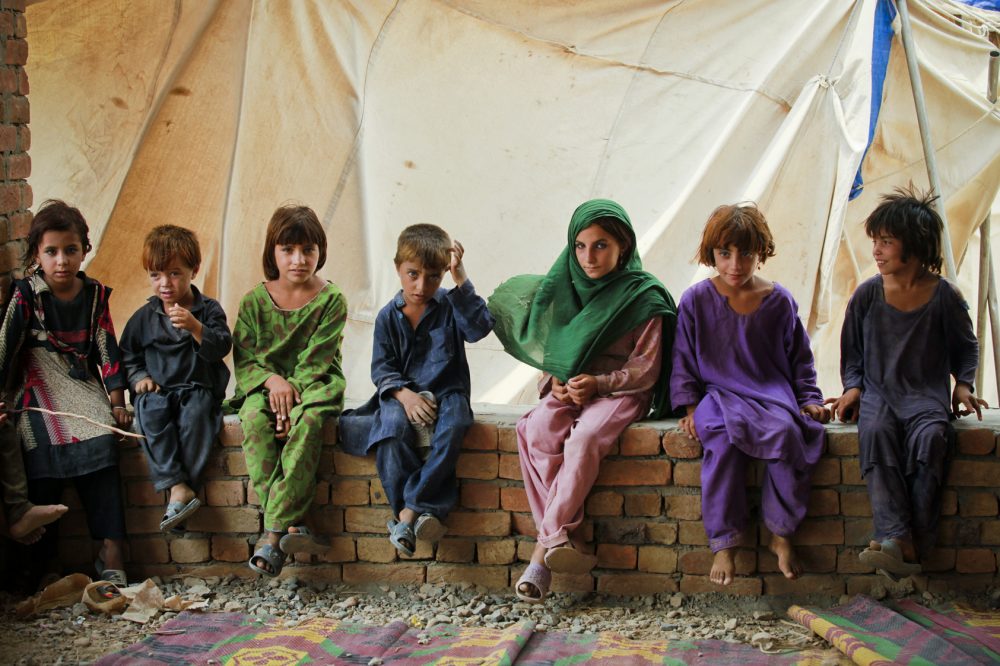
Internally Displaced People
Internally displaced persons are those who have been forced to flee their homes, in particular as a result of armed conflict, generalized violence, violations of human rights or disasters, and who have not crossed an internationally recognized border.
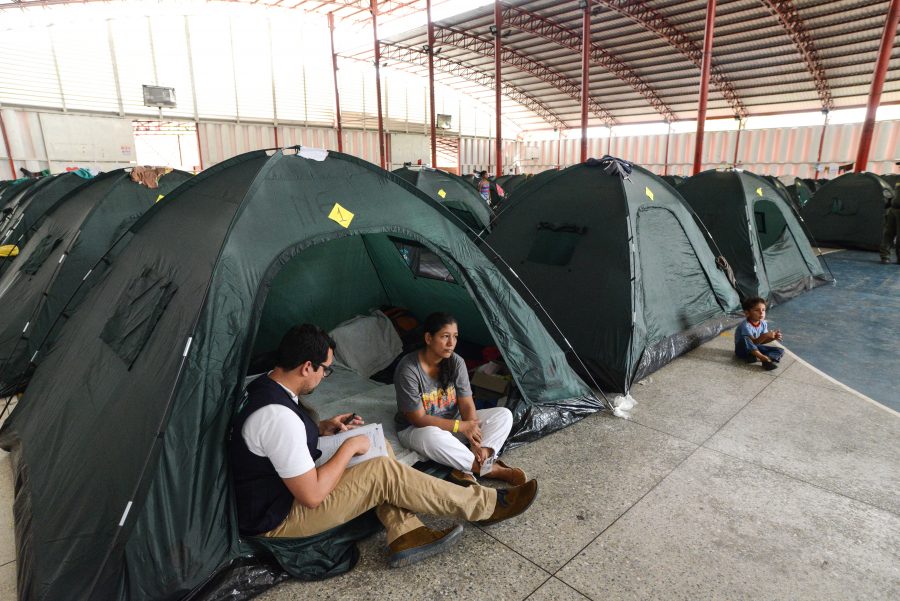
Complex Humanitarian Emergencies
CHEs involve an acute emergency layered over ongoing instability. Multiple scenarios can cause CHEs, like the civil wars in Syria and Yemen, the man-made political crisis in Venezuela, or the public health crisis in Congo.
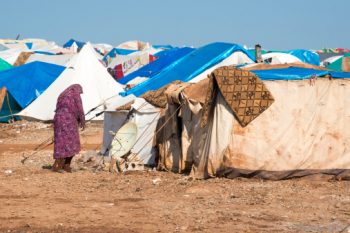
Emergency and Interim Shelter
After a disaster, shelter is more than a place to rest, it is a place of security, access to food, water and medical treatment. A place to start recovering after a disaster.